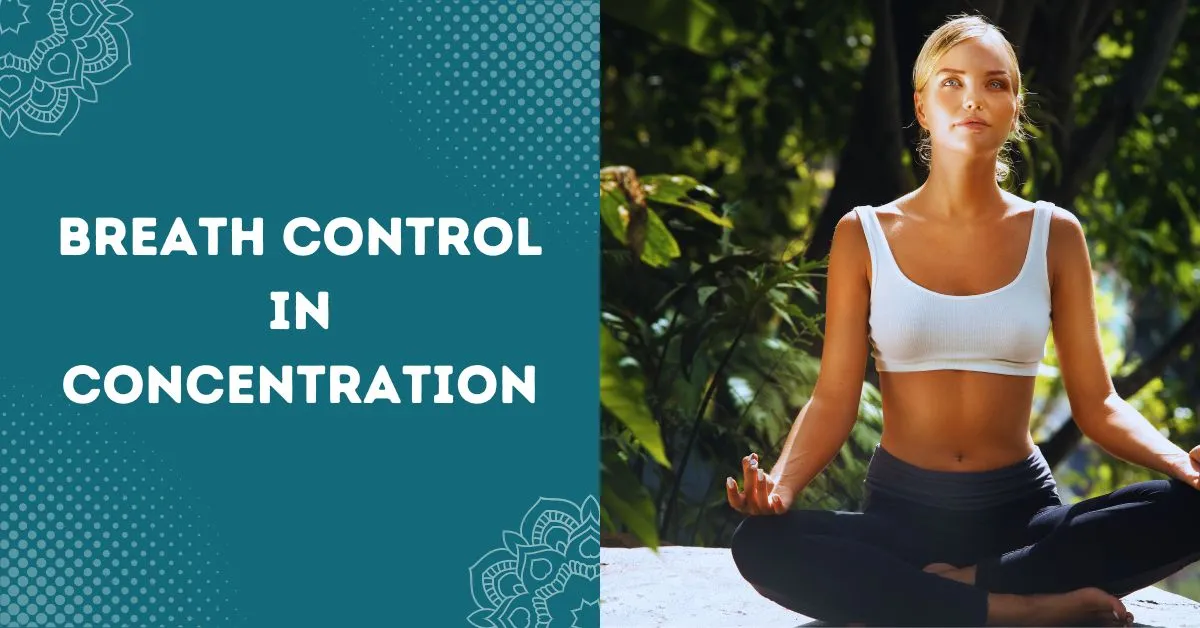In yoga’s embrace, breath’s cadence weaves, concentration’s sanctuary it conceives.
Enhancing Focus and Productivity Through Breath Awareness

In our rapidly evolving world, honing the skill of concentration is imperative, especially amidst the continuous barrage of information and distractions that hinder sustained focus. Nevertheless, an ancient technique, revitalized in modern times, is emerging as a potent remedy – breath control.
This practice offers a compelling solution to bolster concentration, leveraging the power of mindful breathing to cultivate an undistracted mind in the face of contemporary challenges.
The Science Behind Breath and Concentration
Breath control, also known as pranayama in yoga and meditation practices, involves the conscious regulation of breathing patterns.
This practice has a direct impact on the autonomic nervous system, influencing both the sympathetic (fight or flight) and parasympathetic (rest and digest) responses. When we engage in slow, deep breaths, the parasympathetic nervous system is activated, inducing a state of calm and relaxation.
Studies have shown that controlled breathing techniques can significantly improve attention and cognitive performance. Deep, rhythmic breathing increases the supply of oxygen to the brain, enhancing its functionality. Moreover, focusing on the breath serves as an anchor for the mind, helping to redirect attention from distractions back to the present moment.
Techniques for Breath Control
- Diaphragmatic Breathing: Also known as belly breathing, this technique involves inhaling deeply through the nose, allowing the abdomen to expand fully. Exhale slowly and completely, feeling the abdomen contract. This method encourages a slower breathing rate and deeper oxygen exchange.
- Box Breathing: A structured technique, box breathing involves inhaling for a count of four, holding the breath for four counts, exhaling for four counts, and then holding again for four counts. This pattern creates a balanced and controlled breath cycle.
- Counted Breath: Simply counting each breath cycle can help maintain focus. Inhale, exhale, and count “one.” Inhale, exhale, and count “two.” Continue this pattern up to a count of ten, and then start again from one. If the mind wanders, gently bring the focus back to the breath and the counting.
Different Types of Breathing Exercises

Certainly, here are three different types of breathing exercises that you can practice to enhance your concentration:
• Diaphragmatic Breathing (Belly Breathing):
Diaphragmatic breathing, a fundamental technique, encourages the cultivation of deep, unhurried breaths. This practice plays a pivotal role in promoting relaxation and enhancing focus, making it an essential tool for managing stress and improving cognitive performance.
Instructions:
- Find a comfortable sitting or lying position.
- Your chest and abdomen should be touched with one hand each.
- Allow your stomach to rise while you take a deep, slow breath through your nose. This will fill your lungs with air. Your chest should remain relatively still.
- Feeling your stomach drop, exhale through your mouth slowly and fully.
- Continue this deep, controlled breathing pattern for several minutes.
Benefits:
Diaphragmatic breathing helps increase oxygen supply, reducing stress and anxiety. This technique enhances focus by calming the mind and body, making it easier to concentrate on tasks.
• Box Breathing:

Box breathing employs a systematic approach, crafting a well-balanced breath cycle that catalyzes bolstering mental clarity and elevating concentration levels. This deliberate technique harmonizes inhalation, retention, exhalation, and a subsequent pause, syncing with the body’s natural equilibrium.
The result is a profound sense of tranquility within the mind, coupled with a heightened ability to focus. By becoming an unwavering anchor, controlled breath directs the mind away from distractions, enabling an unwavering connection to the present moment and amplifying cognitive prowess.
Instructions:
- Straighten your back and find a comfortable position to sit in.
- Count to four while taking four deep breaths.
- Hold your breath for four counts.
- For a count of four, slowly exhale through your mouth.
- For a count of four, pause and hold your breath.
- Repeat the pattern for several rounds, gradually increasing the count if comfortable.
Benefits:
Box breathing regulates your breath and calms the nervous system, reducing stress and enhancing focus. The structured pattern serves as a mental anchor, helping you stay attentive to the present moment.
• Alternate Nostril Breathing:

Alternate nostril breathing, rooted in yoga, harmonizes the brain’s hemispheres, fostering mental clarity and heightened concentration. This technique involves controlled inhalation and exhalation through alternating nostrils, facilitating a balanced flow of energy and promoting a centered mind.
As a result, practitioners often experience enhanced cognitive function and a deeper ability to engage with tasks, making alternate nostril breathing a valuable practice for refining focus and mental acuity.
Instructions:
- Sit comfortably with your spine erect.
- With your right thumb, cover your right nostril, then take a calm, deep breath through your left nostril.
- Exhale slowly while holding your right ring finger over your left nose and releasing your right nostril.
- Inhale through your right nostril.
- Close your right nostril, release your left nostril, and exhale.
- Repeat this alternating pattern for several rounds, focusing on your breath.
Benefits:
Alternate nostril breathing brings balance to the mind, enhances focus, and reduces mental fatigue. It’s particularly effective for preparing the mind for tasks that require concentration and clarity.
Incorporating Breath Control into Daily Life
Integrating breath control into your daily routine doesn’t have to be complicated. Short, dedicated sessions of focused breathing can yield substantial benefits. Consider setting aside five to ten minutes each day for breath awareness and concentration practice.
Whether it’s during your morning routine, a work break, or before bedtime, these moments of mindfulness can enhance your ability to concentrate and navigate the demands of the day more effectively.
Conclusion: Enhancing Focus and Productivity through Breath Control
In the midst of today’s fast-paced world, mastering concentration has become crucial due to the constant influx of distractions and information overload. Fortunately, the ancient practice of breath control has resurfaced as an effective solution.
This technique, also known as pranayama, directly influences the autonomic nervous system, promoting relaxation and focus. Through methods like diaphragmatic breathing, box breathing, and alternate nostril breathing, individuals can cultivate a calm and centered mind, boosting cognitive performance.
By incorporating breath control into daily routines, even for a few minutes each day, one can harness its transformative potential. This practice empowers us to conquer distractions and navigate modern challenges with enhanced clarity and unwavering focus.
Summary: Key Points to Remember
- In today’s fast-paced world, maintaining concentration amid constant distractions is crucial.
- Breath control is an age-old practice that has gained renewed attention for enhancing concentration.
- Controlled breathing impacts the autonomic nervous system, leading to relaxation and improved focus.
- Techniques like diaphragmatic breathing, box breathing, and alternate nostril breathing offer effective methods for enhancing concentration.
- Incorporating breath control into daily routines through short sessions can lead to significant benefits.
- Breath control empowers individuals to thrive by promoting a calmer mind and improved cognitive function, enabling better attention management in a world full of distractions.
FAQs Related to Breath Control in Concentration:
Q1. What is breath control in concentration?
A: Breath control in concentration refers to the practice of regulating and directing your breath to enhance focus and mindfulness during various activities. It is a technique often utilized in meditation and yoga to promote mental clarity and relaxation.
Q2. How does breath control affect concentration?
A: Breath control can have a profound impact on concentration by calming the mind, reducing distractions, and promoting a state of present awareness. By synchronizing your breath with your focus, you can create a more stable and attentive mindset.
Q3. What are some simple breath control exercises for concentration?
A: Basic breath control exercises include deep diaphragmatic breathing, where you inhale deeply through your nose, allowing your abdomen to rise, and exhale slowly through your mouth. Another technique is the 4-7-8 breath, where you inhale for a count of 4, hold for 7, and exhale for 8.
Q4. Can breath control improve cognitive performance?
A: Yes, studies suggest that controlled breathing can improve cognitive performance. It enhances oxygen flow to the brain, reduces stress, and promotes relaxation, leading to better mental clarity, focus, and decision-making abilities.
Q5. Is breath control suitable for everyone?
A: Yes, breath control techniques are generally safe and beneficial for most individuals. However, people with certain respiratory or cardiovascular conditions should consult a healthcare professional before attempting advanced breath control exercises. Beginners should start with simple techniques and gradually progress.
